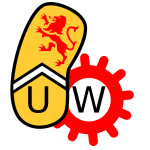Team:Waterloo
From 2008.igem.org
(Difference between revisions)
| Line 21: | Line 21: | ||
|- | |- | ||
| | | | ||
| + | |||
| + | {| style="width:100%; text-align:center;" cellpadding="20" | ||
| + | |- | ||
| + | |style="width:50%;"|<html><a href="http://www.engineering.uwaterloo.ca/"><img src="https://static.igem.org/mediawiki/2008/d/dc/EngFac.PNG" width="300px" height="117px"><br> | ||
| + | Faculty of Engineering</a></html> | ||
| + | |style="width:50%;"|<html><a href="http://www.snc-lavalin.com/"><img src="https://static.igem.org/mediawiki/2008/4/44/SNCLavalin.PNG" width="300px" height="151px"><br> | ||
| + | SNC-Lavalin</a></html> | ||
| + | |} | ||
Revision as of 17:49, 29 October 2008
| Home | The Team | The Project | Parts Submitted to the Registry | Modeling | Notebook | Sponsors |
|---|
| The UW iGEM team is an interdisciplinary undergraduate-run group spanning the faculties of Science, Mathematics, and Engineering. Our undergraduate members and graduate and faculty advisors bring skills, expertise, and perspectives from a broad range of fields, including Biology, Biochemistry, Computer Science, Bioinformatics, Computer and Electrical Engineering, Chemical Engineering, and Mathematical Physics. | ||
|
Our goal is to engineer a genome-free, cell-based expression system capable of producing a desired protein in response to environmental signals. The genome will be degraded by the combined activity of a restriction endonuclease (to fragment the genome) and an exonuclease (to hasten degradation of the genome). The gene for the protein of interest will be located on a plasmid which will lack recognition sites for the endonuclease, enabling it to remain intact after genome degradation. Expression of plasmid genes is expected to continue for a period of time until the "cell" expires. | ||
|
 "
"


